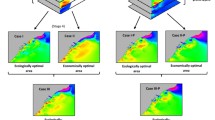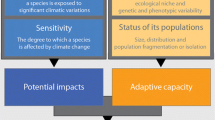Abstract
Protected areas will more efficiently protect biodiversity if threats to the persistence of populations are addressed. Seagrass meadows are globally regarded as critical habitats because of their ecosystem services, human use values, and their diminishing extent. While selecting priority areas for conservation of seagrass meadows is largely aimed at maximizing the protection of their biodiversity, little attention is paid to consider simultaneously the representation of biodiversity and the minimization of threats. This study developed and tested an approach for integrating vulnerability of seagrass meadows to anthropogenic disturbance with the selection of estuarine-protected areas. Vulnerability was measured by data on different land use types in subcatchments. Conservation value was measured by irreplaceability, diversity indices, and rarity of macroinvertebrate species in seagrass meadows. Vulnerability was incorporated into conservation planning by plotting grid cell scores for conservation value versus their scores for vulnerability. The results showed that the performance of the model for the integration of vulnerability into estuarine conservation planning was sensitive to the data treatment. The vulnerability of seagrass meadows and accordingly the arrangement of priority areas for conservation and management attention may change if more information is incorporated into the measurement of vulnerability.








Similar content being viewed by others
References
Angermeier, P.L., and J.R. Karr. 1986. Applying and index of biotic integrity based on stream-fish communities: considerations in sampling and interpretation. North American Journal of Fisheries Management 6: 418–429.
Angermeier, P., and M. Winston. 1997. Assessing conservation value of stream communities: a comparison of approaches based on centres of density and species richness. Freshwater Biology 37: 699–710.
Arnold, C., and J. Gibbons. 1996. Impervious surface coverage: the emergence of a key environmental indicator. Journal of the American Planning Association 61: 243–258.
Cambridge, M.L., and A.J. McComb. 1984. The loss of seagrass from Cockburn Sound, Western Australia: I. The time, course and magnitude of seagrass decline in relation to industrial development. Aquatic Botany 20: 229–243.
Cambridge, M.L., A.W. Chiffings, C. Brittan, L. Moore, and A.J. McComb. 1986. The loss of seagrass from Cockburn Sound. Western Australia. II. Possible causes of seagrass decline. Aquatic Botany 24: 269–285.
Cardno Lawson Treloar. 2008. Brisbane Water Estuary Processes Study. Report prepared for Gosford City Council and Department of Environment and Climate Change (Cardno Lawson Treloar, Gordon). Available at: http://www.gosford.nsw.gov.au/customer/document_gallery/bwemp/brisbane-water-estuary/base_view.
Clark, G., S. Moser, S. Ratick, K. Dow, W. Meyer, S. Emani, W. Jin, J. Kasperson, R. Kasperson, and H. Schwarz. 1998. Assessing the vulnerability of coastal communities to extreme storms: the case of Revere, MA, USA. Mitigation and Adaptation Strategies for Global Change 3: 59–82.
Cutter, S.L. 1996. Vulnerability to environmental hazards. Progress in Human Geography 20: 529–539.
Davis, F.W., D.M. Stoms, R.L. Church, W.J. Okin, and K.N. Johnson. 1996. Selecting biodiversity management areas. Pages 1503–1529 in Sierra Nevada ecosystem project: final report to Congress. Volume II: assessments and scientific basis for management options. Centers for Water and Wildland Resources, University of California: Davis.
Deeley, D.M., and E.I. Paling. 1999. Assessing the ecological health of estuaries in Australia. Marine and Freshwater Research Laboratory. Institute for Environmental Science Murdoch University LWRRDC Occasional Paper 17/99 (Urban Subprogram, report no. 10).
Dony, J.G., and I. Denholm. 1985. Some quantitative methods of assessing the conservation value of ecologically similar sites. Journal of Applied Ecology 22: 229–238.
Duarte, C.M. 2002. The future of seagrass meadows. Environmental Conservation 29: 192–206.
Edgar, G.J., and N.S. Barrett. 2000. Effects of catchment activities on macrofaunal assemblages in Tasmanian estuaries. Estuarine, Coastal and Shelf Science 50: 639–654.
Edgar, G.J., N.S. Barrett, and P.R. Last. 1999. The distribution of macroinvertebrates and fishes in Tasmanian estuaries. Journal of Biogeography 26: 1169–1189.
Ferrier, S., R.L. Pressey, and T.W. Barrett. 2000. A new predictor of the irreplaceability of areas for achieving a conservation goal, its application to real-world planning, and a research agenda for further refinement. Biological Conservation 93: 303–325.
Gaston, K.J. 1994. Rarity. New York: Chapman & Hall.
Gaston, K.J., R.L. Pressey, and C.R. Margules. 2002. Persistence and vulnerability: retaining biodiversity in the landscape and in protected areas. Journal of Biosciences 27: 361–384.
Gillanders, B.M., and M.J. Kingsford. 2002. Impacts of changes in flow of freshwater on estuarine and open coastal habitats and the associated organisms. Oceanography and Marine Biology: An Annual Review 40: 233–309.
Gosford City Council. 1995. Brisbane water plan of management, Gosford City Council, sub-committees and task groups reports, Gosford, NSW, Australia
Gundlach, E.R., and M. Hayes. 1978. Vulnerabilitv of coastal environment to oil-spill impacts. Marine Technology Society Journal 12: 18–27.
Hanna, R.G.M. 1995. An approach to evaluate the application of the vulnerability index for oil spills in tropical Red Sea environments. Spill Science and Technology Bulletin 2: 171–186.
Hatt, B.E., T.D. Fletcher, C.J. Walsh, and S.L. Taylor. 2004. The influence of urban density and drainage infrastructure on the concentrations and loads of pollutants in small streams. Environmental Management 34: 112–124.
Kirkman, H. 1978. Declines of seagrass in northern Moreton Bay, Queensland. Aquatic Botany 5: 63–76.
Kirkman, H. 1997. Seagrasses of Australia. Canberra: Australia: State of the environment, technical paper series (estuaries and the sea). Canberra: Department of the Environment.
Lawler, J.J., D. White, and L.L. Master. 2003. Integrating representation and vulnerability: two approaches for prioritizing areas for conservation. Ecological Applications 13: 1762–1772.
Lister, T.W., J.A. Burger, and S.C. Patterson. 2004. Role of vegetation in mitigating soil quality impacted by forest harvesting. Soil Science Society of America Journal 68: 263–271.
Margules, C.R., and R.L. Pressey. 2000. Systematic conservation planning. Nature 405: 243–253.
Margules, C.R., I.D. Cresswell, and A.O. Nicholls. 1994. A scientific basis for establishing networks of protected areas. In Systematics and conservation evaluation, ed. P.L. Forey, C.J. Humphries, and R.I. Vane-Wright, 327–350. Oxford: Clarendon.
Noss, R.F., C. Carroll, K. Vance-Borland, and G. Wuerthner. 2002. A multicriteria assessment of the irreplaceability and vulnerability of sites in the Greater Yellowstone Ecosystem. Conservation Biology 16: 895–908.
Orth, R.J., T.J.B. Curruthers, W.C. Dennison, C.M. Duarte, J.W. Fourqurean, K.L. Heck, A.R. Hughes, G.A. Kendrick, W.J. Kenworthy, S. Olyarnik, F.T. Short, M. Waycott, and S.L. Williams. 2006. A global crisis for seagrass ecosystems. Bioscience 56: 987–996.
Pethick, J.S., and S. Crooks. 2000. Development of a coastal vulnerability index: a geomorphological perspective. Environmental Conservation 27: 359–367.
Pielou, E.C.E. (ed.). 1976. Population and community ecology. Chicago: Gordon & Breach.
Pimm, S.L., and J.H. Lawton. 1998. Planning for biodiversity. Science 279: 2068–2069.
Pressey, R.L. 1998. Algorithms, politics and timber: an example of the role of science in a public, political negotiation process over new conservation areas in production forests. In Ecology for everyone: communicating ecology to scientists, the public and the politicians, ed. R. Wills and R. Hobbs, 73–87. Sydney: Surrey Beatty and Sons.
Pressey, R.L. 1999. Applications of irreplaceability analysis to planning and management problems. Parks 9: 42–51.
Pressey, R.L., and K.H. Taffs. 2001. Scheduling conservation action in production landscapes: priority areas in western New South Wales defined by irreplaceability and vulnerability to vegetation loss. Biological Conservation 100: 355–376.
Pressey, R.L., I.R. Johnson, and P.D. Wilson. 1994. Shades of irreplaceability: towards a measure of the contribution of sites to a reservation goal. Biodiversity and Conservation 3: 242–262.
Pressey, R.L., S. Ferrier, T.C. Hager, C.A. Woods, S.L. Tully, and K.M. Weinman. 1996. How well protected are the forests of north-eastern New South Wales?—Analyses of forest environments in relation to formal protection measures, land tenure, and vulnerability to clearing. Forest Ecology and Management 85: 311–333.
Pressey, R.L., T.C. Hager, K.M. Ryan, J. Schwarz, S. Wall, S. Ferrier, and P.M. Creaser. 2000. Using abiotic data for conservation assessments over extensive regions: quantitative methods applied across New South Wales, Australia. Conservation Biology 96: 55–82.
Ralph, P.J., D. Tomasko, K.A. Moore, S. Seddon, and C.M.O. McGinnis-Ng. 2006. Human impact on seagrass. In Treatise on seagrass biology, ed. A.W.D. Larkum, R. Orth, and C.M. Duarte, 567–593. Netherlands: Springer.
Rodrigues, A.S.L., R.D. Gregory, and K.J. Gaston. 2000. Robustness of reserve selection procedures under temporal species turnover. Proceedings of the Biological Sciences 267: 49–55.
Schmera, D., and O. Kiss. 2004. A new measure of conservation value combining rarity and ecological diversity: a case study with light trap collected caddisflies (Insecta: Trichoptera). Acta Zoologica Academiae Scientiarum Hungaricae 50: 195–210.
Shannon, C.E., and W. Weaver. 1949. The mathematical theory of communication. Urbana: University of Illinois Press.
Shokri, M., W. Gladstone, and A. Kepert. 2009. Annelids, arthropods or molluscs are suitable as surrogate taxa for selecting conservation reserves in estuaries. Biodiversity and Conservation 18: 1117–1130.
Short, F.T., and S. Wyllie-Echeverria. 1996. Natural and human-induced disturbance of seagrasses. Environmental Conservation 23: 17–27.
Sisk, T.D., A.E. Launer, K.R. Switky, and P.R. Ehrlich. 1994. Identifying extinction threats: global analyses of the distribution of biodiversity and the expansion of the human enterprise. Bioscience 44: 592–604.
Thomson, R. 2007. Brisbane Water Estuary processes study, catchment modelling—MUSIC appendix B. Gordon: Cardno Lawson Treloar Pty Ltd.
Walker, T., R.J. Hudson, and A.S. Gason. 2005. Catch evaluation of target, by-product and bycatch species taken by gillnets and longline in the sharks fishery of South-Eastern Australia. Journal of Northwest Atlantic Fisheries Science 35: 505–530.
White, P.S., and S.P. Bratton. 1980. After preservation: philosophical and practical problems of change. Biological Conservation 18: 241–255.
Williams, P.H. 1998. Key sites for conservation: area-selection methods for biodiversity. In Conservation in a changing world, ed. G.M. Mace, A. Balmford, and J.R. Ginsberg, 211–249. Cambridge: Cambridge University Press.
Wilson, K., R.L. Pressey, A. Newton, M. Burgman, H. Possingham, and C. Weston. 2005. Measuring and incorporating vulnerability into conservation planning. Environmental Management 35: 527–543.
Winston, M.R., and P.L. Angermeier. 1995. Assessing conservation value using centers of population density. Conservation Biology 9(6): 1518–1527.
Zacharias, M.A., and E.J. Gregr. 2005. Sensitivity and vulnerability in marine environments: an approach to identifying vulnerable marine areas. Conservation Biology 19: 86–97.
Acknowledgments
This study was supported by funding from the University of Newcastle and Gosford City Council. Thanks to Dr. P. Freewater at Gosford City Council. Thanks to K. O’Neill and G. Courtenay for their assistance in the field sampling and laboratory works. This project involved a large amount of species identification and this would not have been possible without the generous advice, teaching, and encouragement of Dr. P. Hutchings (Australian Museum). A large number of the species were checked for identification by Dr. Hutchings. The additional assistance at the Australian Museum provided by R. Springthorpe, I. Loch,W. Ponder, and A. Murray, was greatly appreciated. Thanks to Associate Editor of Estuaries and Coasts and three anonymous referees for critical review of an earlier version of this manuscript. The senior author was supported by an IPRS scholarship from the University of Newcastle. Macroinvertebrates were collected in compliance with permits issued by NSW Fisheries.
Author information
Authors and Affiliations
Corresponding author
Rights and permissions
About this article
Cite this article
Shokri, M.R., Gladstone, W. Integrating Vulnerability Into Estuarine Conservation Planning: Does the Data Treatment Method Matter?. Estuaries and Coasts 36, 866–880 (2013). https://doi.org/10.1007/s12237-012-9580-1
Received:
Revised:
Accepted:
Published:
Issue Date:
DOI: https://doi.org/10.1007/s12237-012-9580-1




